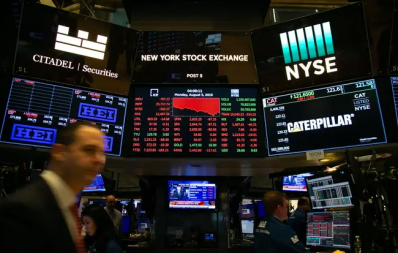The market is forming a consensus: the risk of a US recession is growing
As the U.S. economy continues to overheat and inflation continues to climb, the Federal Reserve may take more severe response measures, and the risk of a U.S. recession is growing. Economists surveyed of 65 business, academic and financial forecasters see a 28 percent chance of a U.S. recession in the next 12 months, up from 18 percent in January and 13 a year ago. %; the risk of a U.S. recession continues to rise as the Federal Reserve gradually raises interest rates in response to high inflation and a series of supply shocks are on the way. Economists slashed their forecasts for economic growth this year, the survey showed. On average, it expects inflation-adjusted GDP to grow by 2.6% year-on-year in 2022, down 1% from its forecast six months ago;
The median economist forecast shows the Fed will adjust rates to 2.125% by the end of 2022 and then to 2.875% by the end of next year. In addition to the catch-up rate hikes, economists also expect inflation to remain elevated, averaging 7.5% in June 2022 and falling to 5.5% by December. Respondents estimated that inflation would fall back to 2.9% by the end of 2023, not far off the Fed's 2% target.
The agency said: the Fed's plan to shrink the balance sheet may put pressure on commodity currencies
Commodity currencies such as the Australian, New Zealand and Canadian dollars have been under pressure as the Federal Reserve plans to rapidly shrink its balance sheet. Commodity currencies could see further corrections in the coming week if global growth concerns continue to intensify. But we still believe that the weakness at this stage is likely to be temporary unless there is a deeper sell-off in global equities. The Australian dollar was down 0.36% at 0.7427 after hitting a near three-week low of 0.7418, while the New Zealand dollar was down 0.12% at 0.6834 after hitting a near four-week low of 0.6813.

European countries are discussing putting a Russian oil embargo on the agenda
The European Union officially passed the fifth round of sanctions against Russia, deciding to phase out coal purchases from Russia. While sanctions on Russia appear to be over, starting this week, European countries will discuss a more ambitious goal: weaning themselves off Russian oil, even as EU officials seek to make oil the next major step in sanctions against Russia. However, the discussions are unlikely to come to fruition anytime soon. German parties still disagree with the proposal to ban Russian oil imports, despite German Chancellor Scholz's previous assertion that imports from Russia may be halted this year. At the same time, EU officials said they were wary of moving too quickly, fearing it could affect the French presidential election;
UBS: U.S. release of crude oil reserves is expected to have limited impact on oil prices
UBS has cut its near-term oil price forecast while raising its forecast for oil prices later this year, as it expects the release of crude oil reserves in the United States to have only a short-term impact. UBS lowered its oil price forecast for the second quarter by $10, while raising its oil price forecast for the fourth quarter of 2023 and the first quarter of 2023 by $10. UBS now expects oil prices to hover around $115 a barrel each quarter through the first quarter of 2023. The bank said the U.S. will release 180 million barrels of oil over the next six months, which should put some pressure on prices, but expectations that the U.S. will buy back oil later this year to replenish inventories should have the opposite effect.
Biden's release of crude oil reserves could backfire if not replenished quickly
The Biden administration is selling record quantities of emergency oil from the National Reserve to try to stem the surge in U.S. fuel prices as soon as possible, but the plan could backfire if those reserves are not replenished quickly; starting in May, the U.S. will withdraw from the Strategic Petroleum Reserve ( SPR) sold 180 million barrels of crude oil at a rate of 1 million barrels per day, the largest outward sell-off since the reserve was established in the 1970s. Other members of the International Energy Agency (IEA) will also release an additional 60 million barrels of crude oil to curb global oil prices; the SPR’s decision to sell oil is also an exchange: oil will be released to the market at a faster rate to ensure oil prices fall, but It may take longer to replenish inventories and return to pre-dumping levels, raising long-term market risks. Analysts warned that this could make oil prices more volatile.
Market risk aversion is still high, and the performance of gold prices may be stronger
In the past two weeks, the precious metal market has remained volatile as a whole, and gold has traded within a narrow range of $1920-$1950 most of the time. The precious metal market is affected by both monetary policy and geopolitics. Although the Fed has been hawkish recently and interest rate hike expectations have continued to rise, the situation in Russia and Ukraine has not improved for a long time, making the market risk aversion still high, hedging part of the impact. On the other hand, the main platinum and palladium trading market announced the suspension of Russian platinum and palladium delivery last Friday, which further amplified the volatility of platinum group metals. In the follow-up, if the rate of increase in US interest rate hike expectations slows down and the interest rate hike is gradually transformed from expectations into reality, the performance of gold prices may be stronger.
Fed doesn't believe aggressive water withdrawals will weigh on economy
The minutes of the Fed's March meeting previously released showed that "many" policymakers at the meeting were preparing to raise interest rates by 50 basis points in the next few months. Policymakers also want to shrink balance sheets starting as early as May as a second way to raise the cost of credit for businesses and households. Inflation will remain high this year and next, even if the Fed moves to steadily reduce the pace of price increases. Aggressive action by the Fed in the short term "will help reduce excess demand and reduce upward pressure on prices to reach the Fed's 2% inflation target." Stay above 2%, but the trajectory of inflation will shift downward. "
The West continues to increase sanctions
Russian troops bombed targets in eastern Ukraine with missiles and artillery last Sunday (April 10). Washington has pledged to provide Ukraine with "the weapons it needs" to fend off a new Russian offensive. The West continues to seek a broader energy embargo on Russia. Lured by deep discounts, India has bought at least 13 million barrels of Russian crude since Russia invaded Ukraine in late February. The US and UK have banned Russian oil. The United States has made it clear that it does not want to see increased imports of Russian energy from India. The White House said President Biden will hold a virtual meeting with Indian Prime Minister Narendra Modi on Monday.
 2022-04-12
2022-04-12
 1177
1177






 简体中文
简体中文
 ภาษาไทย
ภาษาไทย
 繁體中文
繁體中文
 Indonesia
Indonesia











